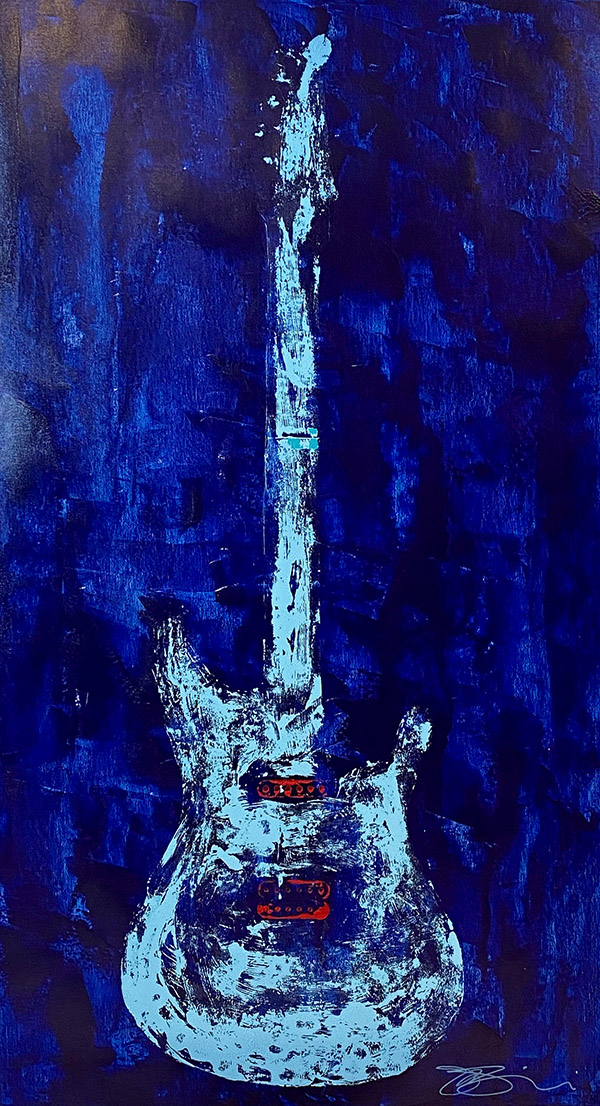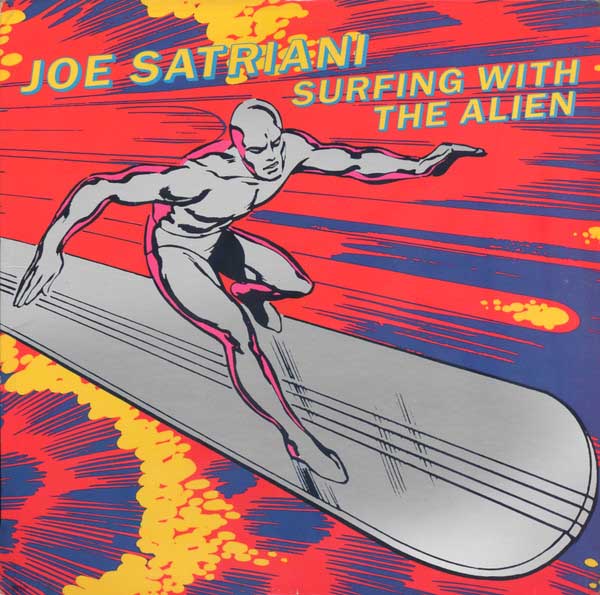Joe Satriani on the Spacious New Atmos Mix of His Career-Defining 1987 Album, Surfing With the Alien

Guitar maestro Joe Satriani has been making strange beautiful music for well over four decades and counting. Given his penchant for exploring the very concept of space itself and all of its dimensions, it should come as no surprise that Satch has wholly embraced the concept of having his music mixed in Dolby Atmos.
“I spent the last couple of months on and off doing the Atmos remix of Surfing With the Alien,” Satriani confirms, referring to the groundbreaking instrumental October 1987 album that essentially launched his career into the, well, stratosphere. “It was really interesting to revisit that album, just sitting in Dave Way’s studio with John Cuniberti. We were just revisiting how we felt about the album, the sequencing, and the two songs we left off it.”
How Satriani and his lifelong friend and co-producer Cuniberti initially approached the stereo mix of Surfing ultimately led to how their Atmos mix unfolded into a fully enveloping and challenging 360-degree mix you can hear in all its glory on Apple Music, for starters. “We made lots of decisions back in ’87 to get that record to be just right,” Satriani continues. “It really echoed what we had to go through with [April 2022’s] The Elephants of Mars because it was a big record. Ultimately for me, I felt subject matter, tempos, and key signatures had to be complimentary when you are asking someone to sit down and listen to something in sequence.”
Fact is, Satriani has always been quite the visualizer when it comes to the creation of his music, and Surfing With the Alien could be considered his true liftoff nexus point. (Brief sidenote: If you want to see Satriani’s literal visualization of his own work via original canvases and hand-painted guitars as seen under the quite-apropos umbrella title “Beyond Reality,” Satch has a pair of showings scheduled at two Wentworth Gallery locales on the East Coast in March. Go here for all the details—and, in the meantime, see the following example of his guitar-riffic artwork below.)

Recently, Satriani, 66, and I got on Zoom together to discuss just how cosmically cool Surfing With the Alien sounds in Atmos, which specific track benefits the most from its Atmos mix, and what earlier surround mix from his storied catalog he considers to be “the most beautiful thing ever.” Always with me, always with you. . .
Mike Mettler: Tell me about how you first got into Atmos. Was it presented to you as a mixing option for your catalog, or did you already have an interest in it?
Joe Satriani: Well, I knew about Atmos from many years ago. My good friend Michael Semanick, who is an Oscar-winning film sound [re-recording] mixer, was actually an engineering assistant on [October 1989’s] Flying in a Blue Dream, so I’ve known Michael for a long time as an engineer. [To date, Semanick has won two Oscars for his film work—he garnered one for 2003’s The Lord of the Rings: The Return of the King, and the other for 2005’s King Kong.]
When I started working at Skywalker [Sound, at Skywalker Ranch in San Francisco], very often, Michael would be there mixing movies, and I’d get to see what was going on in there, which was really wonderful. He told me about Atmos at the very beginning and how exciting it was, and how it really benefited the movie experience—and then we started that discussion about how it would work for a rock band. The great thing is that anytime you can increase the enjoyment of listening to music, it’s worth going down that road if there’s some new technology. It’s like going from mono to stereo.
The economic thing, though, is a bit risky. When somebody goes to make a record, there’s a budget, and there’s a column called “Mixing,” which is a big chunk of it. Then someone says, “Oh, by the way, that column there—double it or triple it, because we’ve got 360, and we’ve got Atmos and quad and 7.1 and 5.1.” It’s an economic headache, because then you’ve gotta take money out of making the album and stick it into this sort of remix [budget column].

The good thing about it is, there are times when mono fails and stereo fails to live up to the promise of the piece of music. And what I found in working with Dave Way and with John Cuniberti again was that we found a way to improve Surfing With the Alien, because we had to really remember, “What did we feel a little let down about when we were mixing it back then [in 1987]?”
Mettler: Is there one Surfing track you would say is the best Atmos demo track for what you did with the format, the one listeners can get started with? Is there one you can quantify in that way?
Satriani: Well, all of them sound great! (both laugh) But I gotta say, I’m really, really pleased with it overall. I thought, to a certain degree, one of the tracks that was difficult for us at the time [of the original mixing] was “Lords of Karma.” I’m not quite sure why—it may have been because it had a lot of [Roland] JC-120 amp in it, where some of the other songs had maybe three different amplifiers on them. So, there was a lot of ganging up of frequencies, and it was just one of those mixes where John and I thought, “Well, it could have been better if we had another 10 grand to remix this!” (laughs)
But when I sat down and I was listening to the Atmos mix of it, I said, “You know, I swear this is sounding better to me than what I remember!” I put headphones on and listened to the stereo mix, and then we put the stereo mix up [for playback in the studio] and it was like, “Yes! The Atmos actually, finally makes this song as big as it should be!” I was very happy about that.
And here’s something the customer, the listener, probably doesn’t really grasp—and it’s not really their problem—but when you get to the final stages of mixing, you go through what they call a stereo bus. The stereo bus has got some limiting or compression on it—and what that does is, it does the final gluing together of everything. It manages everyone in the band playing louder and softer at different times. It makes sure that one “pokey” thing never really pokes out so that one quiet thing is still enjoyable.
When that mix goes to the mastering engineer, he handles the finer elements to make sure it’s balanced in volume, and also that there aren’t frequencies that have somehow escaped the mix to jump out and poke you in the eye, or something like that—or make everything sound dirty and muddy.
When they do Atmos and 360 [Reality Audio], there’s none of that! There’s no mastering! And this is the weird thing about it—you’re really dealing with an album that was made, let’s say 30-35 years ago, and each track has been turned into a digital stem. And then they take that stem and add different environments to it to make it sound like it’s over here, or over there, or behind you—whatever you want.

But the final thing is—there’s no mastering! So, it really is a brand-new thing the original engineers and producers have to come to grips with. Let’s say if you and I had an Atmos studio and someone brought in an album that we never heard before, we wouldn’t really care to the same degree. We’d be so happy to put reverb over here and not worry about the backslap, or whatever. But the original engineer and artist—they’d be horrified because it’s not their vision of the music, you see?
But that mastering stage is still missing, in a way. That has been the sound of recorded music for, I don’t know, five decades—that sound of big tube compression. Think about listening to “She Said She Said” by The Beatles without the Fairchild compressors and limiters, you know what I mean? It doesn’t work! (laughs)
[MM notes: “She Said She Said” is, of course, is the last song on Side 1 of The Beatles’ seminal August 1966 album, Revolver—an album that also has its own truly stunning Atmos mix.]
Mettler: (laughs) You’re right—you can’t even fathom “She Said She Said” without that. Now that you’ve done everything the right way for Surfing, have you been thinking about how you’ll do the rest of your catalog in Atmos, now that you’ve experienced it positively?
Satriani: Well, we started thinking about that right away. I mean, John [Cuniberti] and I have been creating stems of everything, and remixes for clinic purposes where it’s the Minus One mixes. [Those are mixes created specifically for educational purposes, intended for anyone who wants to learn how to play, and/or play along to, Satriani’s music.] Some of the albums are difficult, like Flying [in a Blue Dream] and [July 1992’s] The Extremist—you know, the 48-track things.
Mettler: Right—the album that is literally the most in extremis! (laughs)
Satriani: (laughs) Yeah, that’ll be a tough one! But John’s done quite a bit of it already, actually. And we did talk about if there was some way to get it [the Satch-catalog-in-Atmos thing] going. Even though I’m not signed to Sony at this point [Satriani currently licenses his new music to the Edel Music/earMUSIC label family], we’re still partners together with my catalog, and they have taken it upon themselves to pay for this Atmos/360 stuff. It’s completely in their ballpark—but we’ve told them we’re into it. I think it’s just a matter of whether they see Atmos really taking off—and then they’re gonna wanna turn everything into Atmos.

Mettler: Well, I vote for your entire catalog getting the full Atmos treatment. And, for the record, we do have to acknowledge that [June 2002’s] Strange Beautiful Music came out on SACD with a surround mix back in the day, so those 14 tracks are kind of close to being in Atmos already.
Satriani: Close, yeah. Um, wow, Strange Beautiful Music in 5.1—I mean, the last time I heard that was when I was in Studio D [at The Plant] in Sausalito, [California]. I remember hearing the song “You Saved My Life” in 5.1 in the studio, with it coming out as the most beautiful thing ever, you know? (chuckles) It’s wonderful.
Mettler: I agree. And that’s such a great track to revisit in surround, for sure.
Satriani: Yeah. The thing is—and I’m not sure how it’s gonna work out—the labels are gonna have to pay for it, because you can’t expect artists to pay to remix their whole catalog. That would be 18 albums for me—so, I mean, come on! (laughs) There’s an added expense there, so I hope a dialogue is happening between the labels and the services that goes something like, “Are you gonna help us out?”
The artist in me hopes it all works itself out, because I do want my customers and fans to have a choice between listening to the original albums the way they first came out in stereo, as well as listening to the Atmos mixes of them I’ve approved.






























































